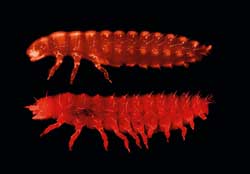For decades honeybees have been battling American foulbrood—a disease so infectious, compromised hives often must be burned to the ground.
Treating foulbrood is complicated because the disease can evolve to resist antibiotics and other chemical treatments. Losing entire hives not only disrupts the honey industry, but also reduces the number of bees for pollinating plants.
But undergraduate student Bryan D. Merrill (BS ’14), funded by a BYU ORCA (student mentoring) grant, has produced a natural way to eliminate the scourge, and it’s working: Using tiny killer viruses known as phages to protect baby bees from infection.
“Phages are the most abundant life-form on the planet, and each phage has a unique bacteria that it will attack,” says Sandra Burnett, BYU professor of microbiology and molecular biology. “[Phages] can target specific bacteria while leaving all other cells alone.”
Although phages are plentiful, finding the perfect phage for the job takes a lot of hunting—a hunt Merrill has been on since Burnett’s “Phage Hunters” class his freshman year.
“This bacteria has been a problem in honeybees for a long time,” Merrill says. “It infects the larva. . . . It doesn’t hurt the adult bees, but all of a sudden the bees can’t replenish the population and the hive just collapses.”
When hives are infected, beekeepers generally treat their hives with antibiotics. However, this is usually only a temporary solution. If the bacteria returns, it will most likely have developed a resistance to the antibiotics.
“[A] phage is a great alternative to antibiotics, and it’s a natural alternative,” Burnett says. “It multiplies itself so there are more of them to hunt down the bacteria.”
Once they identify the perfect phage, Burnett, Merrill, and other students replicate it in the lab so it can be applied to the hive with a sugar-water solution. Like a virus, the phages get to work, eliminating the harmful bacteria, saving hives, honey, and the plants and crops bees pollinate.
After a lot of gene sequencing and analyzing, Merrill has identified five phage candidates for honeybee treatment, cleverly named after former BYU basketball stars (Abouo, Davies, Emery, Jimmer1, and Jimmer2). His findings appear in the high-ranking biotechnology journal BMC Genomics.
After applying the phage treatment to a beekeeper’s infected hive, Merrill says, “We can see noticeable improvement . . . which is really satisfying, to know that something we developed in the lab is actually working in the field.”









